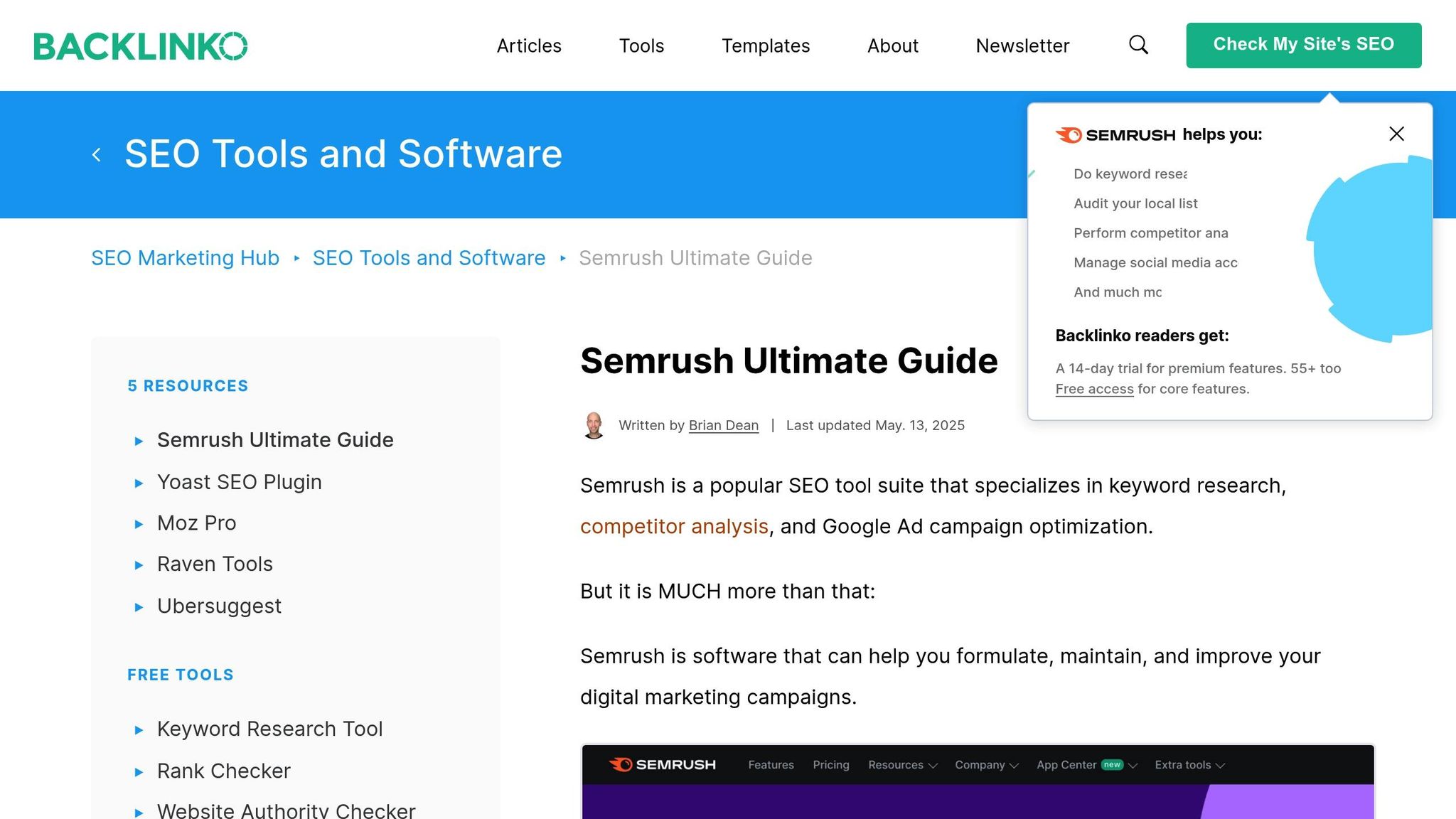How to Measure ROI from SEO Campaigns
September 22, 2025Measuring ROI from SEO campaigns boils down to understanding the financial return compared to the costs invested. SEO is a long-term strategy, so tracking results over time is key. Here's how you can calculate and evaluate your SEO ROI effectively:
- Track Costs: Include agency fees, tools, in-house labor, and content creation expenses.
- Measure Revenue: Attribute revenue to organic traffic using tools like Google Analytics or CRM systems.
- Key Metrics: Focus on organic traffic growth, conversion rates, and revenue attribution.
- ROI Formula: Use this formula: [(SEO Revenue - SEO Costs) / SEO Costs] × 100.
- Challenges: Multi-touch attribution, delayed results, and seasonal trends can complicate tracking.
For example, if you spend $78,000 on SEO in a year and generate $245,000 in revenue, your ROI is 214%. Use tools like Google Analytics and SEMrush to track performance and refine strategies over time. Remember, SEO takes months to show results, so patience and consistent tracking are essential.
The ROI of SEO - The Ultimate Guide & Calculator
Key Metrics for Evaluating SEO ROI
To measure the return on your SEO efforts effectively, you need to focus on the right metrics. These metrics help bridge the gap between your SEO strategies and actual business outcomes.
Organic Traffic Growth
Organic traffic growth measures how many users are finding your site through search engines over time. It tracks sessions, unique visitors, and pageviews, offering a clear view of your site's visibility.
A practical way to assess this is by comparing month-over-month and year-over-year data. For instance, if your website had 10,000 organic sessions in January and 12,500 in February, that’s a 25% increase. However, it’s not just about the numbers. The quality of this traffic is just as important. Metrics like session duration, pages per session, and bounce rate help gauge how engaged these visitors are. High-quality traffic often means longer visits and fewer bounces.
You can also dig deeper by analyzing geographic and device data. For example, if your target audience is in specific U.S. states, tracking traffic from those areas can provide valuable insights. Similarly, understanding the split between mobile and desktop traffic is critical, especially with the growing dominance of mobile searches in the U.S. These insights are essential when evaluating how effectively your traffic converts.
Conversion Rates from Organic Search
Conversion rate reflects the percentage of organic visitors who complete a desired action on your site, such as making a purchase, filling out a form, or signing up for an email list. For e-commerce sites, this could mean sales, while for lead-generation businesses, it often involves capturing contact details or inquiries.
Keep in mind that organic visitors often take longer to convert compared to paid traffic, as they’re typically in the research phase. This distinction is crucial for setting realistic expectations.
To calculate your organic conversion rate, divide the number of conversions from organic traffic by total organic sessions, then multiply by 100. For example, if you had 1,000 organic sessions in a month and 25 of those visitors made a purchase, your conversion rate would be 2.5%.
Segmenting this data by landing page or device type can uncover patterns. Tracking both macro conversions (like sales or form submissions) and micro conversions (such as newsletter sign-ups or content downloads) gives a more complete picture of user behavior.
Revenue and Lead Value Attribution
One of the most critical metrics is tying visitor activity to financial outcomes. For e-commerce businesses, revenue attribution links specific sales to organic traffic by tracking which visitors make purchases and how much they spend. To do this effectively, you’ll need robust tracking systems that capture the entire customer journey, even when users switch devices during the process.
Looking at customer lifetime value (CLV) can provide a broader perspective. For example, if your average customer makes three purchases at $150 each, their CLV is $450. This metric helps you see the long-term impact of your SEO efforts.
For lead-generation businesses, assigning monetary values to leads is key. Say 20% of consultation requests convert into clients, and the average contract is worth $5,000. In this case, each consultation request could be valued at $1,000.
Attribution can get tricky when customers interact with your brand multiple times before converting. Different models - like first-click, last-click, or linear attribution - offer various ways to allocate credit. Using multiple models can give you a more rounded view of your SEO performance.
Cost of SEO Investment
To calculate ROI accurately, you also need a clear understanding of your SEO costs. These include both direct and indirect expenses. Direct costs might cover agency fees, subscriptions to analytics tools, or payments to freelancers. For example, if you spend $3,000 per month on an SEO agency and $200 on tools, your direct monthly investment is $3,200.
Labor costs are another major factor, especially for in-house teams. For instance, if a content manager’s fully loaded annual cost is $80,000 and they dedicate 50% of their time to SEO, $40,000 should be allocated to your SEO budget.
Other costs to consider include content creation (writing, design, production) and infrastructure expenses like hosting or content management system licenses. Keeping track of all these costs over time ensures your ROI calculations reflect the true, long-term investment in your SEO efforts.
Step-by-Step Process to Calculate SEO ROI
This guide breaks down how to connect your SEO investments to measurable business outcomes using a clear, step-by-step approach.
Identify SEO-Related Costs
Start by listing all your SEO expenses. Missing even small costs can distort your ROI calculations and lead to poor business decisions.
First, look at direct costs. These are the obvious ones, like agency retainers, freelancer fees, and software subscriptions. For instance, if your monthly direct costs add up to $4,650, make sure all these expenses are accounted for.
Next, calculate internal labor costs, which are often overlooked but can be the largest expense. This includes salaries, benefits, payroll taxes, and overhead for team members working on SEO. For example, if your content manager earns $65,000 annually but costs the company $85,000 with benefits and taxes, and they spend 60% of their time on SEO, you should allocate $51,000 of their total cost to your SEO budget.
Don't forget indirect costs that support SEO efforts. These might include website hosting, premium WordPress themes, stock photography subscriptions, and CMS licenses. A mid-sized business might spend $200 per month on hosting, $50 on design tools, and $100 on content resources, which adds up to $4,200 annually.
Content creation expenses also play a big role. If you’re producing four blog posts per month at $300 each, plus $200 for graphics, you’re spending $2,000 monthly on content. Technical improvements like site speed optimization or mobile responsiveness updates should also be included if they’re directly tied to SEO.
Once you’ve tracked all your costs, the next step is to link your SEO efforts to revenue.
Calculate Revenue or Lead Value from SEO
To measure SEO revenue accurately, you need to connect organic search traffic to tangible business outcomes using tools like analytics and CRM systems.
For e-commerce businesses, set up goal tracking in Google Analytics to isolate revenue from organic search traffic. For example, if organic traffic brought in $125,000 in revenue over the past year, that’s your SEO revenue.
Using multi-touch attribution models can help you better understand the full customer journey.
Lead-generation businesses should assign monetary values to conversions. Track form submissions, phone calls, and consultation requests that come from organic search. Collaborate with your sales team to determine conversion rates and average deal values. For instance, if organic search generates 50 qualified leads monthly, and 15% of those leads convert into clients worth $8,000 each, your monthly SEO revenue is $60,000 (50 × 0.15 × $8,000).
For service-based businesses, it’s essential to track both immediate conversions and long-term relationship-building. For example, a law firm might value an initial consultation at $500, while a consulting firm might assign different values to actions like white paper downloads ($25), webinar registrations ($100), or direct inquiries ($1,000).
Use your CRM to follow the entire customer lifecycle. Tag leads that originated from organic search and track their progression through the sales funnel. This provides a more accurate picture of SEO-driven revenue than relying solely on web analytics.
Apply the SEO ROI Formula
Once you’ve identified your costs and revenue, use this formula to calculate ROI: [(SEO Revenue - SEO Costs) / SEO Costs] × 100. This will give you the percentage return on your SEO investment.
Example: Imagine an e-commerce business invests $78,000 in SEO over 2024. This includes $48,000 in agency fees, $18,000 in internal labor, $7,200 for tools, and $4,800 for content creation. Their organic search traffic generates $245,000 in revenue. Using the formula: [($245,000 - $78,000) / $78,000] × 100 = 214% ROI. This means for every dollar spent on SEO, they earned $2.14 in profit.
For lead-generation businesses, the calculation works similarly but requires careful lead valuation. A B2B software company spends $92,000 on SEO in 2024, including $60,000 in agency costs, $24,000 on internal resources, and $8,000 on tools. Their SEO efforts generate 180 qualified leads, and historical data shows 22% of leads convert into customers with an average contract value of $15,000. The revenue attributed to SEO is: 180 leads × 0.22 conversion rate × $15,000 = $594,000. Using the formula: [($594,000 - $92,000) / $92,000] × 100 = 546% ROI.
Tracking ROI monthly can also provide actionable insights. If your monthly SEO costs are $6,500 and you generate $18,200 in organic revenue in August 2025, your monthly ROI is [($18,200 - $6,500) / $6,500] × 100 = 180%.
Keep in mind that negative ROI periods are common, especially early in an SEO campaign. For instance, if you invest $8,000 in SEO during your first three months but only generate $3,500 in organic revenue, your ROI would be [($3,500 - $8,000) / $8,000] × 100 = -56%. This doesn’t mean your strategy is failing - SEO often takes 6–12 months to deliver meaningful results.
To get a clearer picture, calculate ROI over different timeframes. While a quarterly view might show -25% ROI, an annual review could reveal a much higher return as your rankings and traffic grow over time.
sbb-itb-cef5bf6
Tools for Tracking and Reporting SEO ROI
Once you’ve got a handle on calculating SEO ROI, the next step is using the right tools to connect your efforts to measurable results. These tools don’t just make tracking easier - they provide the data you need to refine your strategy and make informed decisions.
Using Google Analytics for SEO ROI

Google Analytics is a go-to tool for understanding SEO performance. Start by setting the currency to US dollars and aligning the time zone with your location. The Acquisition reports (found under Acquisition > All Traffic > Channels) allow you to see how organic search contributes to revenue. For e-commerce businesses, Enhanced E-commerce tracking offers a detailed look at the customer journey, from initial views to completed purchases. If your focus is on lead generation, you can set up goals for actions like form submissions, phone calls, or consultation requests. By assigning monetary values to these conversions - using historical data - you can better quantify your ROI.
Another key feature is Google Analytics' attribution models, which help you understand how SEO fits into the broader customer journey. You can also create custom segments to spotlight high-quality traffic, giving you a clearer view of which SEO efforts are making the biggest impact.
For deeper insights, pairing Google Analytics with tools like SEMrush can take your analysis to the next level.
Using SEMrush for Performance Insights

SEMrush offers a range of tools to help you evaluate SEO ROI more effectively. The Position Tracking tool monitors keyword rankings and estimates the traffic value of those positions. Meanwhile, the Organic Research feature identifies which keywords drive the most traffic, enabling you to fine-tune your strategy for better results.
SEMrush also offers Traffic Analytics, which estimates competitors’ organic performance. This can help you set realistic goals for your own campaigns. The Backlink Analytics tool tracks the impact of your link-building efforts on rankings, while the Content Audit tool highlights opportunities to optimize pages that already draw significant traffic but could perform better in terms of conversions.
SEO Werkz Reporting Capabilities

SEO Werkz builds on these tools by consolidating data into a single, easy-to-read view of your SEO ROI. Here’s what the platform brings to the table:
- Monthly Reporting: Automatically compiles data from multiple platforms into one dashboard, saving you the hassle of manually pulling reports.
- Customized Campaigns: Tailors reporting to your specific business goals, whether you’re tracking product sales, leads, or sign-ups. This ensures that the metrics align with your unique conversion events and revenue goals.
- Industry-Specific Insights: Provides benchmarking data for various industries, helping you understand how your ROI stacks up against competitors.
- Proprietary Tools: Advanced attribution modeling tracks the entire customer journey across multiple touchpoints. This includes activities like link building and reputation management, giving you a complete picture of SEO’s role in driving revenue.
With these tools, you can move beyond guesswork and base your SEO decisions on hard data, maximizing both your insights and your results.
Best Practices and Common Challenges
Measuring SEO ROI isn’t always straightforward - it requires a well-thought-out approach to navigate the complexities of search engine optimization. By following proven strategies and addressing common hurdles, you can create a system that delivers reliable insights.
Best Practices for SEO ROI Measurement
Stick to consistent reporting periods that align with your business cycles. While monthly reporting is common, quarterly reviews often provide a clearer perspective on trends, as search rankings and organic performance can vary week by week. A steady reporting schedule helps you identify patterns over time.
Update conversion goals regularly to match your evolving business objectives. For instance, if your initial focus was on newsletter sign-ups but has since shifted to demo requests, make sure your tracking reflects this change. Outdated goals can skew your results.
Segment traffic by geographic regions within the U.S. to uncover regional performance trends. You might find that certain areas have higher conversion rates, which can guide decisions about resource allocation and content customization.
Establish baseline metrics before rolling out new SEO initiatives. Record your current organic traffic, conversion rates, and revenue attribution. This will give you a clear starting point to measure the impact of your efforts over time.
Use consistent currency formatting in reports. Since you’re focusing on U.S.-based performance, stick to USD formatting with standard comma separators. This ensures clarity when comparing data across different periods.
While these practices set a strong foundation, there are still challenges that can complicate accurate measurement.
Common Challenges and Solutions
Multi-touch attribution often makes it tricky to measure SEO ROI. For example, a customer might first find your business through organic search, engage with your brand on social media, and then convert via a direct visit.
One way to address this is by using time-decay attribution models. These models give more weight to interactions closer to the conversion while still acknowledging earlier touchpoints. Tools like Google Analytics support this approach, offering a more balanced view of SEO’s contribution to revenue.
Delayed ROI impact is another challenge, as SEO strategies typically take months to show measurable results. To track progress in the meantime, monitor leading indicators like keyword rankings, click-through rates, and engagement metrics.
Valuing non-ecommerce conversions can be difficult for service-based businesses. Instead of assigning arbitrary dollar amounts, analyze historical data to estimate the impact of actions like consultation requests or whitepaper downloads. For example, if a percentage of consultation requests leads to high-value clients, you can calculate an estimated value per request and update it as your data becomes more robust.
Seasonal fluctuations can also distort ROI calculations. To account for this, establish baselines and compare performance year-over-year to identify trends without being misled by seasonal spikes or dips.
Comparison of Attribution Models
To navigate these challenges, it’s essential to choose an attribution model that aligns with your customer journey. Here’s a breakdown of common models and their strengths and weaknesses:
| Attribution Model | Ideal For | Advantages | Disadvantages |
|---|---|---|---|
| First-Click | Brand awareness campaigns, top-of-funnel content | Highlights the initial discovery; useful for tracking early engagement | Overlooks later interactions that drive conversions |
| Last-Click | Direct response campaigns, bottom-of-funnel optimization | Simple and clear; attributes conversions directly | Undervalues earlier touchpoints in the buyer’s journey |
| Linear | Balanced attribution across channels | Provides an even view of all interactions | May dilute the importance of key conversion moments |
| Time-Decay | Long sales cycles, B2B services | Gives more weight to recent interactions while recognizing earlier ones | Can be complex to set up and explain |
| Position-Based | Multi-channel campaigns with distinct phases | Emphasizes both the first and last interactions | Relies on arbitrary weighting for middle touchpoints, which might not suit all businesses |
For SEO ROI measurement, time-decay attribution is often a strong choice. It acknowledges that organic search often plays a crucial role early in the customer journey while still crediting later interactions that drive conversions. However, if your sales cycle is short, a last-click model might offer better clarity on SEO’s immediate impact.
Ultimately, the best approach is to test multiple models using your actual data. Many businesses find value in using one model for content strategy decisions and another for assessing overall ROI. This dual approach can provide a more nuanced understanding of how SEO contributes to your goals.
Conclusion: Connecting SEO to Measurable Results
Turning the metrics and tools we’ve discussed into actionable strategies is the final step in making SEO work for your business. Measuring SEO ROI allows you to shift from guesswork to data-backed decisions. This guide has covered key metrics like organic traffic growth, conversion rates, and revenue attribution, alongside the tools and formulas needed to determine your returns.
Start by establishing clear benchmarks and tracking progress regularly. SEO doesn’t deliver overnight results - it’s a long-term effort. With consistent monitoring, however, you’ll gain a reliable understanding of your performance over time.
Google Analytics is indispensable for tracking organic traffic and conversions, while platforms like SEMrush offer a closer look at keyword performance and competitor trends. For businesses that need more detailed reporting, services like SEO Werkz can link your SEO efforts directly to revenue, providing a clearer picture of your financial outcomes.
Another key factor is selecting the right attribution model to better understand SEO’s role in your sales funnel. Whether you opt for first-click, last-click, or time-decay models, your choice should align with your business goals and sales cycle. Testing various models can help you see how SEO influences different stages of the customer journey, complementing insights from tools like Google Analytics and SEMrush.
As you move forward, prioritize consistent tracking and analysis over trying to achieve flawless precision. By sticking to the basics laid out in this guide and adapting based on what your data reveals, your SEO efforts can become a reliable driver of measurable results.
FAQs
How can I measure the revenue generated by SEO when customers use multiple channels before purchasing?
To understand how SEO drives revenue when customers interact with multiple channels, multi-touch attribution models are key. These models distribute credit across all the touchpoints in a customer’s journey - whether it’s organic search, social media, or paid ads - giving you a fuller view of SEO’s role in conversions.
Tools like Google Analytics' Multi-Channel Funnels make it easier to track these interactions and assign revenue accurately. By examining how organic search works together with other channels, you can clearly showcase SEO’s impact on your overall marketing performance and revenue goals.
What are the most common mistakes businesses make when calculating SEO ROI, and how can they avoid them?
One of the biggest missteps businesses make when evaluating SEO ROI is placing too much emphasis on vanity metrics like website traffic or keyword rankings. Sure, these numbers can show progress, but they often fail to reveal how your efforts are impacting what truly matters - your revenue or profit.
Another common issue is not factoring in all the costs tied to an SEO campaign. Expenses like tools, labor, or agency fees are often overlooked, leading to skewed ROI figures. On top of that, businesses sometimes ignore external influences, such as seasonal changes or broader industry trends, which can distort performance data.
To steer clear of these errors, prioritize metrics that tie directly to your revenue. Think conversion rates, customer lifetime value, and sales driven by organic traffic. Tools like Google Analytics can help you gather precise data, but make sure your calculations reflect actual cash flow, not just surface-level metrics. When you align your SEO strategy with clear business objectives, you'll get a much clearer picture of your investment's true impact.
How long does it take to see a positive ROI from SEO, and what should I track while waiting?
Most businesses begin to see a return on their SEO investment within 6 to 12 months, though the timeline can vary. Some might spot progress as early as 3 months, while others could wait up to 2 years. The difference often comes down to factors like competition, the industry you're in, and how strong and well-executed your SEO strategy is.
While you're waiting for the results to roll in, it's important to keep an eye on a few key metrics to track your progress:
- Organic traffic growth: Keep tabs on how many visitors are landing on your site through search engines. It's a great way to gauge whether your efforts are paying off.
- Keyword rankings: Check if your target keywords are climbing the search engine results pages (SERPs). This is a direct indicator of your SEO performance.
- Conversion rates: Measure how effectively your site visitors are turning into leads or customers. After all, traffic is only valuable if it drives action.
- Revenue attribution: Connect specific revenue increases to your SEO activities. This helps you understand the direct financial impact of your strategy.
By monitoring these metrics, you'll get a clearer picture of how your SEO campaign is performing and ensure you're moving closer to your goals.






